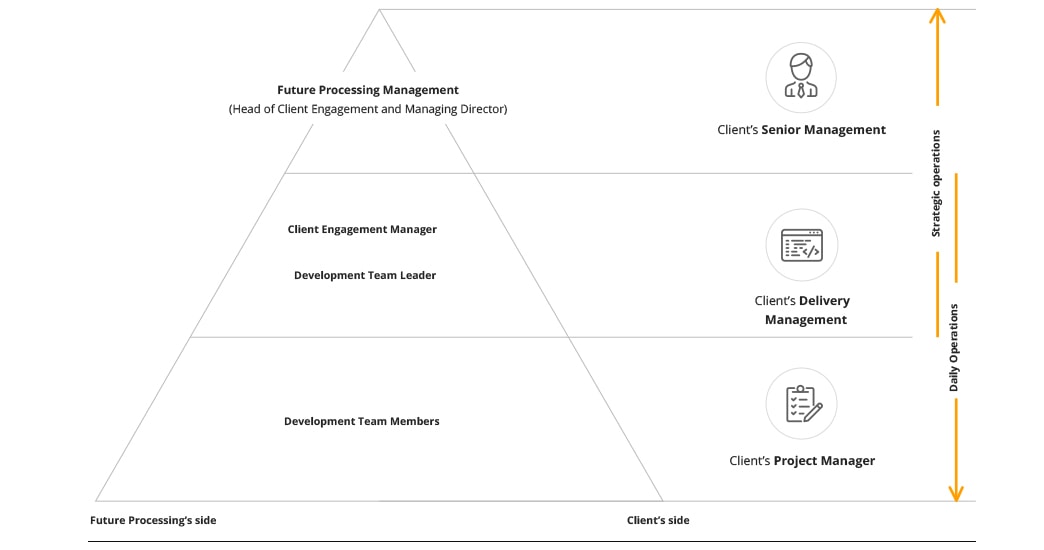
Governance structure – why is it so important in project management?
Governance structure refers to the framework of project management, especially regarding rules, procedures, roles and the division of responsibilities within the whole decision-making process. It keeps the project in check, allowing it to run flawlessly and in accordance with the plan.
We can even say that having a governance structure is critical to a project’s success, as it provides clear guidelines on how to react in various situations and takes a lot of chaos out of the equation.
What’s important in governance structure?
The governance structure of any project should be based on a few main principles, so that it is fully applicable throughout the entire process, regardless of the phase of the project:
- Logic – the established framework should be reasonable and make sense to everyone involved.
- Adequacy – there isn’t a set governance structure that works for everyone; this is something that should always be adjusted to the organisation or project at hand.
- Transparency – all information regarding the governance structure has to be clearly stated, understandable and available to every team member.
- Repeatability – the mechanisms and procedures involved should be all-encompassing, so that they can be applied repeatedly to any given situation.
- Efficiency – the governance structure should allow any project to run as smoothly and productively as possible; it has to be solution-oriented.
What are the main roles within the governance structure?
The active roles within the governance structure depend on the chosen project management methodology. Usually, you may encounter all or only some of these roles:
- Project Owner – separate from stakeholders, the project owner is responsible for steering the project in the right direction, so that the results meet the client’s needs, values and expectations.
- Project Manager – responsible for running the project on an operational level, the project manager clarifies priorities and coordinates work.
- CTO – focused exclusively on the technical side of the project.
- Team leaders – they organise tasks within smaller teams of designers or specific developers.
- Stakeholders – they make decisions on the highest level: by defining needs, presenting expectations, and communicating changing business goals.
- Steering Committee – generally speaking, this is a group of people, including the project manager and stakeholders, that monitors and approves the general progress of the project as well as the outcomes.
Governance structure in practice – the Future Processing Way
Client Engagement Manager – our success factor
First of all, in order to facilitate strategic planning for both the project and project resources, we assign one of our expert Client Engagement Managers (CEMs) to the client’s account. The CEM’s main duty is to ensure that the client is satisfied with the service we deliver and then work together with the client to plan a timeline for any upcoming new projects.
Governance schedule
The purpose of our governance schedule is to establish and maintain clear organisational structure, as well as transparent processes and practices for managing the client-company relationship. We have it all written down on paper and present it to everyone who is involved in the project, so it’s clear who is responsible for what, and how we should deal with emerging issues, step by step. There’s no room for any guesswork, since the project has to move forward effectively, and timely delivery is one of our biggest priorities.
The schedule includes governance principles, roles, responsibilities, committee structures and protocols. This facilitates cooperation, aligns the interests of both parties, simplifies the implementation of any modifications and amendments, and structures the process of partial or complete termination of any services.
Governance operating model
Our governance operating model is based on these essential rules, which should be respected by both parties:
- be proactive with a flexible and responsive attitude, as this directly translates into efficient and seamless development;
- focus on client satisfaction and the customer experience, so that all of their needs can be fulfilled;
- practice active management that inspires action and keeps the project going;
- prioritize innovation and continuous improvement in order to deliver state-of-the-art outcomes, always of the highest quality;
- maintain harmony within the processes, especially between both parties;
- collaborate with a win-win attitude, so that project success translates into achieving or maintaining a competitive advantage for both our client and ourselves;
- communicate frequently and clearly, so that everything is transparent and there are no bottlenecks to slow down project development;
- review and approve key decisions through management control, in order to make sure that the project proceeds in the right direction.
Governance meetings
Meetings are a vital part of our governance model, which are held on different management levels and concern various aspects of the project:
- Strategic Review
We have a Strategic Review every six months – this is a face-to-face meeting between both our client’s senior leadership teams and our own. It is all about presenting and adjusting the strategic vision and agenda for the months to come, discussing new opportunities and requirements, and reviewing financial performance. - Monthly Operational Meeting
This meeting is held once a month and it is where we discuss resourcing updates, project performance against KPIs, and any risks and issues as notified by the teams. - Weekly Operational Meeting
The most frequently held meeting, during which we review progress reports and key delivery risks, and talk about any issues regarding current project delivery.
Of course, before each of the above-mentioned meetings, we present a list of participants along with a clear agenda, so that everyone has a chance to prepare and knows what to expect.
Benefits of having a governance structure
Having a well-established governance structure brings a lot of benefits to the entire cooperation, particularly in terms of work efficiency and transparency. We’ve noticed:
- less bottlenecks or hurdles in the decision making process because the procedures and division of responsibilities are clearly defined;
- increased reliability and trust from our clients since the risk of potential misunderstandings or communication issues are reduced to a minimum;
- a better view into the progress of our projects due to the open and transparent attitude embraced by management on every level.
If a project lacks a governance structure, then it is easy to get stuck and lose your sense of direction. That’s why we place special emphasis on this matter, and make sure the governance model for each project is well-structured prior to any cooperation, so that our team and our clients are prepared, fully informed and ready for action.





